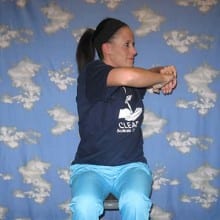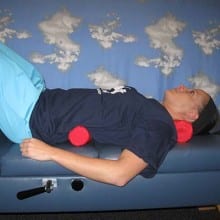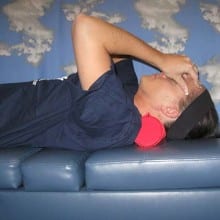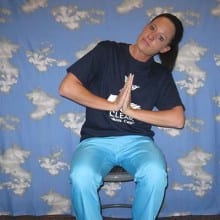One of the most commonly-asked questions received by the CLEAR Scoliosis Institute from patients is, “What exercises can I do to help my scoliosis?” Unfortunately, this is a very difficult question to answer without having an opportunity to work with someone in person, review their x-rays and curve pattern, examine their posture and muscle tone, etc. In this section, we do our best to provide some generic scoliosis back exercises which may be helpful in promoting good spinal health.
Please note that, for a more effective and comprehensive exercise program, it is necessary to consult with a CLEAR certified doctor directly. CLEAR Institute is not responsible for the success or lack thereof that may result as a consequence of performing these scoliosis back exercises, nor can we be held liable for any injuries or negative side effects that may occur. Please perform these exercises carefully and follow all instructions. By doing these scoliosis back exercises, you acknowledge that it is at your own risk.
These two scoliosis back exercises should always be performed together; first the warm-up, then the cool-down. You can begin with the Spinal Rotation Exercise and then perform additional exercises, but you must finish with the Spinal Molding Cool-Down. This ensures that when the discs of the spine cool down after exercising, they do so in the proper alignment to ensure good spinal health.
The discs of the spine are living structures that require water and nutrients to survive. Before the age of 13, blood vessels supply the spinal discs with what they need to stay healthy (this is why you never find young children with disc problems). This blood supply to the spinal discs atrophies (dies) after puberty. The only way the discs stay healthy after this point is through motion; water & nutrients are pumped into the disc every time pressure is taken off the disc, and waste is pumped out each time pressure goes back on (like squeezing a sponge).
For optimal spinal health, these two exercises should be performed every morning right away when you wake up, and at night before you lie down to go to sleep. Keeping your teeth healthy involves much more than just going to the dentist – you also need to brush your teeth everyday. Likewise, good spinal health involves more than just going to see a chiropractor every now and then; it can only be maintained through caring for your spine everyday, on a regular basis.
The discs of the spine have hydrogel properties that allow them to change from a fluid to a gel state depending upon the core temperature. You can take advantage of this to “mold” the curves of your spine into place.
Performing this exercise is like hitting the “RESET” button on your spine. It can redistribute the stress of gravity from your muscles back to your spine where it belongs, decreasing neck & low back pain and muscle soreness.
To raise your core temperature and liquefy the discs, perform the Spinal Twist exercise. This gets the bones of your spine moving; motion creates friction, and friction creates heat. After you are done performing the Spinal Twist, you will be able to place a hand on your back and feel the warmth radiating from your spine.

First, sit up straight and raise your arms to shoulder level with your elbows bent. Also, keep your chin up to maintain the curve in your neck. Then, pick a spot behind you and slowly twist your torso and neck to look at it. You should rotate slowly at first to stretch your muscles, and gradually increase your speed as the discs begin to liquefy, increasing your ranges of motion. Twist back and forth for at least 25 full rotations (50 half-rotations); if your spine is not warmed up after 25 repetitions, you may do another 25.
After your spine is warm, you may proceed with your regular exercise program. Once your exercises are complete, you must then cool down with the Spinal Molding Therapy.

Lie down with spinal supports under your neck (placed just above the shoulders, letting the head come all the way back) and under the small of your back. You can fold a regular size bath towel in half, fold in the sides, and roll it up, using rubber bands to hold the edges, to create a firm cylinder roughly 3 ½” to 4” in diameter. The support should be as firm as possible; however, many people who have a loss of the good curves in the spine (the cervical and lumbar lordosis) might find these supports uncomfortable at first. If this happens, switch to a less firm or less thick support, and try to work up to firmer and thicker supports gradually. Raising your knees will also take some of the pressure off of your low back while performing this exercise. Set a timer for 20 minutes, and relax. Don’t get up before then! It takes at least 20 minutes for the discs of your spine to cool and revert back to a gel state. Once they do, they will cool with the good curves in place. Having good curves in your neck and low back is important to ensure your spine has the strength and stability it needs to absorb shocks (if you doubt this, try jumping and landing without bending your knees!)
If you are interrupted after doing the Spinal Twist and do not give your spine a chance to cool down while molding the curves in place, be very mindful of your posture for the next half-hour. The curves will set in whatever position you maintain during this time. This warning also applies after you exercise, work in the garden, etc. If you allow your spine to cool down in an abnormal position, the result with be muscle tension, soreness & pain.

This exercise strengthens the flexor muscles in the front of the neck. Having a good balance between the strength of the muscles in the front of the neck (cervical flexors) and the muscles in the back of the neck (cervical extensors) helps to prevent the good curve in the neck (lordosis) from being lost, and can also help with forward head posture.
To perform this exercise, lie down on your back with a foam roll or rolled-up towel under your neck. Place your fingertips on your forehead, and resist lightly against your fingertips while trying to tuck your chin. Do not allow your head to move (do not lift your head up). Isometric exercises (performed without motion, against resistance) are more effective in strengthening the core postural muscles than isotonic exercises (those performed with motion).

This exercise strengthens the extensor muscles in the back of the neck.
Start with the head and neck straight forward, and the hands clasped on the crown of the head. The elbows should be close together. The head is then tilted back while applying resistance with the hands, held for five seconds, then returned to a neutral position. Do NOT pull your head forward and down!

This exercise works the extensor muscles in the low back.
The hands are placed on the knees. Look up while arching the low back, and pull on the knees with your fingers (or push with the palms)
to accentuate the curve in your low back. The shoulders should be kept back. Be sure to keep the chin up as well. Hold this position for five seconds.
These two exercises (Cervical Extension and Lumbar Extension) should be performed ten times, twice a day, or whenever you find yourself sitting down at a desk or working on a computer for long periods of time.

The purpose of this exercise is to restore the thoracic kyphosis, stretch the rhomboid muscles, and improve lung capacity.
First, bring your hands above your head while taking a deep breath. The hands are then pushed together as they are brought down, as you exhale. Press your hands into your diaphragm, below the ribs, to expel the last of your air. Then, take a deep breath in as you continue to press against your diaphragm. When your lungs are full, suddenly pull your hands away. You should then feel your rib cage expand as air rushes into your lungs.
Be sure to keep your chin up the entire time you are performing this exercise.

Always be sure to keep the curve in your neck & low back while performing this (and every) exercise. Repeat ten times, twice a day.
For additional information about exercises to help with scoliosis, please consult with a CLEAR doctor, or visit our Physical Therapy page for more information about other exercise-based approaches to scoliosis rehabilitation.
CLEAR provides a unique and innovative way of understanding scoliosis. Sign up to receive facts and information you won’t find anywhere else.
